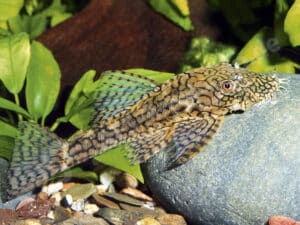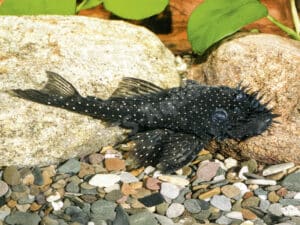In the DATZ article “Four new L numbers for long-known Ancistrus species,” Ingo Seidel presents four bristlenose plecos in DATZ 02 2025 that have been common in the hobby for many years but have only been traded under their place of origin or fantasy names until now. As part of our work on the new standard reference work “Bristlenose Catfishes: The Plecos of the Genus Ancistrus” he now assigns the code numbers L 529 to L 532 to these proven aquarium fish. This makes them more clearly identifiable within the group of L-Numbers and easier to distinguish from one another.
L 529 – Tocantins Wormline Bristlenose Catfish
L 529 originates from the Rio Tocantins basin in northeastern Brazil and was previously listed as Ancistrus sp. “Rio Tocantins.” It differs from the species L 156, also known from this river system, in its gray-brown, somewhat broader and flattened body with a fine, black wormline pattern on the head, which becomes coarser towards the tail. There are wavy dark lines on the fins. Males have medium-length, relatively fine, partly branched tentacles. The species reaches about 12 cm and is well suited for small to medium-sized aquariums with warm, oxygen-rich water. Seidel reports successful breeding in a 200-liter tank with mixed tap/osmosis water (pH about 6.5–7.3, conductivity 300–450 µS/cm, 28–29 °C). . The animals reach sexual maturity at 6–7 cm and spawn in caves after larger water changes; the first clutches contain about 40–50 eggs, with significantly higher numbers of young fish possible in older animals.
L 529 originates from the Rio Tocantins basin in northeastern Brazil and was previously listed as Ancistrus sp. “Rio Tocantins.” It differs from the species L 156, also known from this river system, in its gray-brown, somewhat broader and flattened body with a fine, black wormline pattern on the head, which becomes coarser towards the tail. There are wavy dark lines on the fins. Males have medium-length, relatively fine, partly branched tentacles. The species reaches about 12 cm and is well suited for small to medium-sized aquariums with warm, oxygen-rich water. Seidel reports successful breeding in a 200-liter tank with mixed tap/osmosis water (pH about 6.5–7.3, conductivity 300–450 µS/cm, 28–29 °C). . The animals reach sexual maturity at 6–7 cm and spawn in caves after larger water changes; the first clutches contain about 40–50 eggs, with significantly higher numbers of young fish possible in older animals.
L 530 – Snowflake Pleco
The catfish known as Ancistrus sp. “Snowflake” also gets its own number with L 530. It is a slender species from the Rio Negro basin that grows to a size of 10–12 cm and is exported via Manaus. Its body and fins are deep black and densely covered with bright white spots, which form a particularly strong contrast on the fin rays; these spots are also found on the tentacles of the males. L 530 is occasionally imported together with other Rio Negro species, but is mainly present in the hobby through captive breeding. A smaller tank with slightly acidic water that is not too hard is sufficient for keeping them; a strong current is not essential. For breeding, Seidel recommends soft water with a conductivity below 400 µS/cm, a pH of 6–6.5, and temperatures around 25–27 °C. Young breeding pairs initially produce only 10–20 fry per clutch, but later 50–60 are possible. The young fish grow rather slowly, develop the typical white spots after a few weeks and initially have a white border on their tail fin, which disappears with age.
The catfish known as Ancistrus sp. “Snowflake” also gets its own number with L 530. It is a slender species from the Rio Negro basin that grows to a size of 10–12 cm and is exported via Manaus. Its body and fins are deep black and densely covered with bright white spots, which form a particularly strong contrast on the fin rays; these spots are also found on the tentacles of the males. L 530 is occasionally imported together with other Rio Negro species, but is mainly present in the hobby through captive breeding. A smaller tank with slightly acidic water that is not too hard is sufficient for keeping them; a strong current is not essential. For breeding, Seidel recommends soft water with a conductivity below 400 µS/cm, a pH of 6–6.5, and temperatures around 25–27 °C. Young breeding pairs initially produce only 10–20 fry per clutch, but later 50–60 are possible. The young fish grow rather slowly, develop the typical white spots after a few weeks and initially have a white border on their tail fin, which disappears with age.
L 531 – Starry Night Dwarf Pleco
L 531 is a particularly small pleco that Seidel has been studying since the 1990s. The first specimens arrived in the hobby around 1996 as Ancistrus sp. “Starry Night” via the company Trop Rio, presumably from the Rio do Pará system in northeastern Brazil. Later, Transfish also imported this species. Adult specimens grow to only 6–8 cm in length and have fine, bright white dots on a deep black body; The belly is light gray and unspotted. The caudal fin is indented inward, the lower lobe significantly longer, with white tips in young animals. This makes L 531 reminiscent of L 107/L 184, in which, however, both tail lobes are elongated into filaments. Aquariums from 60 cm are sufficient for keeping them, but with warm, well-aerated water and not too high a hardness (26–30 °C). Seidel succeeded in breeding them several times in a 90-liter tank at approximately neutral pH, 450 µS/cm, and 28–29 °C. The animals lay a few very large eggs in small clay cavities; the clutches remain small, and accordingly, larger schools of young fish are rarely successful. The initial white ring patterns on the young fish are striking, later closing to form the typical dots.
L 531 is a particularly small pleco that Seidel has been studying since the 1990s. The first specimens arrived in the hobby around 1996 as Ancistrus sp. “Starry Night” via the company Trop Rio, presumably from the Rio do Pará system in northeastern Brazil. Later, Transfish also imported this species. Adult specimens grow to only 6–8 cm in length and have fine, bright white dots on a deep black body; The belly is light gray and unspotted. The caudal fin is indented inward, the lower lobe significantly longer, with white tips in young animals. This makes L 531 reminiscent of L 107/L 184, in which, however, both tail lobes are elongated into filaments. Aquariums from 60 cm are sufficient for keeping them, but with warm, well-aerated water and not too high a hardness (26–30 °C). Seidel succeeded in breeding them several times in a 90-liter tank at approximately neutral pH, 450 µS/cm, and 28–29 °C. The animals lay a few very large eggs in small clay cavities; the clutches remain small, and accordingly, larger schools of young fish are rarely successful. The initial white ring patterns on the young fish are striking, later closing to form the typical dots.
L 532 – Greenish Brilliant Pleco
The “Greenish Brilliant Pleco” listed under L 532 was introduced in 2010 via Aquarium Glaser from the Rio Tocantins and initially passed on as L 180. However, the original L 180 presented in the 1994 DATZ magazine is broader in build, more flattened and always has clearly spotted fins, while the form introduced later has a much more brilliant coloration. To highlight these differences, Seidel proposes the new number L 532 for the newer form. The species grows to a length of about 13 cm, is black-gray in color and often appears greenish depending on the lighting. Distinctly contrasting, round, whitish to yellowish spots stand in stark contrast to the background, while the fins are usually barely spotted; juveniles have a white border on their tail fin. Males develop strong “antlers” made of heavily branched tentacles. A well-filtered, warm aquarium with additional flow and plenty of oxygen is recommended for keeping them. Seidel successfully socializes L 532 with Peckoltia and Hypancistrus species. In a 200-liter tank with a temperature of 28–29 °C, pH 6.8–7.3, and 300–400 µS/cm, he succeeded in breeding them several times in pointed clay caves; young parents produced 30–40 fry per clutch, older ones even more, which grow slowly but are robust.
The “Greenish Brilliant Pleco” listed under L 532 was introduced in 2010 via Aquarium Glaser from the Rio Tocantins and initially passed on as L 180. However, the original L 180 presented in the 1994 DATZ magazine is broader in build, more flattened and always has clearly spotted fins, while the form introduced later has a much more brilliant coloration. To highlight these differences, Seidel proposes the new number L 532 for the newer form. The species grows to a length of about 13 cm, is black-gray in color and often appears greenish depending on the lighting. Distinctly contrasting, round, whitish to yellowish spots stand in stark contrast to the background, while the fins are usually barely spotted; juveniles have a white border on their tail fin. Males develop strong “antlers” made of heavily branched tentacles. A well-filtered, warm aquarium with additional flow and plenty of oxygen is recommended for keeping them. Seidel successfully socializes L 532 with Peckoltia and Hypancistrus species. In a 200-liter tank with a temperature of 28–29 °C, pH 6.8–7.3, and 300–400 µS/cm, he succeeded in breeding them several times in pointed clay caves; young parents produced 30–40 fry per clutch, older ones even more, which grow slowly but are robust.
Detailed profiles and further information on Ancistrus species – including the new L numbers – can be found at Ancistrus.at and in the Ancistrus species list.
Anyone who would like to delve deeper into the systematics, habitats, care, and breeding of all known Ancistrus species will find this information in the bilingual standard work “Bristlenose Catfishes: The Plecos of the Genus Ancistrus” (Bristlenose Catfishes: The Plecos of the Genus Ancistrus) at ATS Aquashop.




